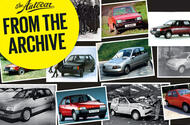The Eastern Bloc had a burgeoning car industry during the 80s and 90s, until a major political upheaval
In the late 1980s, the Eastern bloc’s communist governments realised their countries’ potential for car making and owning and strove to supersede their terrible old smokers with modern metal.
“We’ve decided to increase our car production from 1.3m in 1987 to 2.5m by 1995,†said Valentin Morozov, the car industry’s first deputy minister in the USSR – the bloc’s domineering power and by far its biggest car maker, ahead of Poland (303k), East Germany (210k), Czechoslovakia (188k), Yugoslavia (171k) and Romania (120k).
In 1989, Fiat became the first Western car maker to enter a joint venture with the USSR, planning to annually build 300k examples each of the new 1125 compact hatchback and new 1111 mini car.
It was all part of the USSR’s plan to turn Elabuga (on the Volga river but 370 miles east of the GAZ site that made Volga-badged cars) into a Russian Turin, creating the new EIAZ brand. The city was to be expanded massively, its population rising from 70k to 300k, to support this wholesale transformation of the old KamTZ tractor factory.
Enjoy full access to the complete Autocar archive at themagazineshop.com
Fiat was uniquely trusted behind the Iron Curtain, having sold production licences there in the 1960s, giving rise to the FSO 125p in Poland, Zastava 125pz in Yugoslavia and VAZ Zhiguli in the USSR (exported as the Lada 1200). So it was brought in to help create the VAZ 1111 (or Lada Oka abroad), which entered production in 1988 in Tolyatti, and then an enhanced version, the EIAZ 1121 ‘Kama’.
Amazingly, Porsche agreed to design an engine for that, having worked with the USSR before – a tiny four-stroke twin with 35bhp.
Meanwhile, the 1125 was being engineered with no major carry-over Fiat parts and styled with help from Italdesign in Turin. VAZ rejected Fiat’s innovative new 1.1-litre Fire engine in favour of its own 56bhp 1.0-litre unit – and it also rejected Giorgetto Giugiaro’s design in favour of the droopy, oddly named Debut proposal by the USSR’s central automotive research lab, NAMI.
To us, NAMI would have been better off using its Kompakt design of 1988. At least Italdesign’s work didn’t go to waste, in 1993 being repurposed as the Fiat Punto. As it happened, neither the 1121 nor the 1125 ever materialised, as the Elabuga EIAZ hub was never built, following the unexpected collapse of the USSR in 1991.
Capitalism tore through the former Soviet republics, changing societies and economies entirely, and so when Elabuga did get a car factory in 1995, it was one run by General Motors. Americans!
Some cars from this period of planned modernisation and growth did see daylight, though.
For instance, the ZAZ 1102 ‘Tavria’, a smaller sibling of the VAZ 2108 ‘Samara’, in the modern front-drive/front-engine mould. Albeit the 1102 endured a difficult gestation amid the upheaval of new Soviet leader Mikhail Gorbachev’s transparency era, resulting in it earning a bad reputation among those used to the Zaporizhzhia plant’s ancient rear-drive/rear-engine ZAZ 966 ‘Zaporozhets’.
There was also the Moskvitch 2141 (or Lada Aleko) that in 1986 began rolling out of Moscow’s AZLK factory looking suspiciously like Talbot’s Alpine and using a Fiat engine, and the IZH 2126 ‘Oda’, which was made in Izhevsk from 1990 (alongside Kalashnikov rifles).
Outside of the USSR, Fiat also contributed to the modernisation of Zastava, giving it engines from its excellent new Tipo and a design by Giugiaro to create the Florida (or Sana in the UK). It couldn’t escape political upheaval either, though, as Yugoslavia was ripped apart in a bloody civil war through the 1990s.
Today, the Zastava factory is in Serbia, owned entirely by Fiat and being refitted in order to build the forthcoming electric Panda.
FSO wasn’t as fortunate: its own 1980s modernisation drive came to nought, as it simply couldn’t raise the money to start producing its new Wars hatchback – a shame, as a prototype drive impressed us. It was bought by Daewoo so no longer makes cars. Compatriot FSM was luckier, bought by Fiat and put to work on the new Cinquecento.
East Germany also left it too late: its government signed a deal with Volkswagen that was to result in an all-new Trabant hatch, but the Berlin Wall fell shortly after, so the Zwickau factory started making Polos and Giugiaro’s cool X03 proposal was evolved into the second-generation Seat Ibiza.
To round things off with Czechoslovakia and Romania, well, how many Skodas and Dacias do you see each day?

